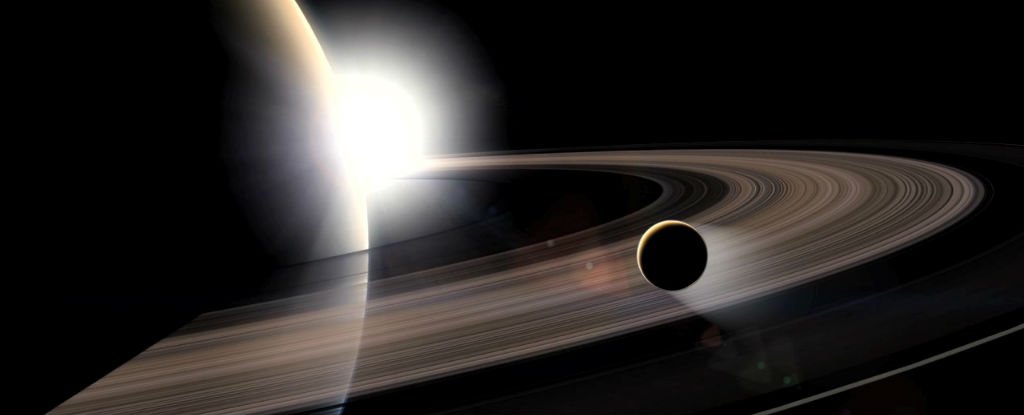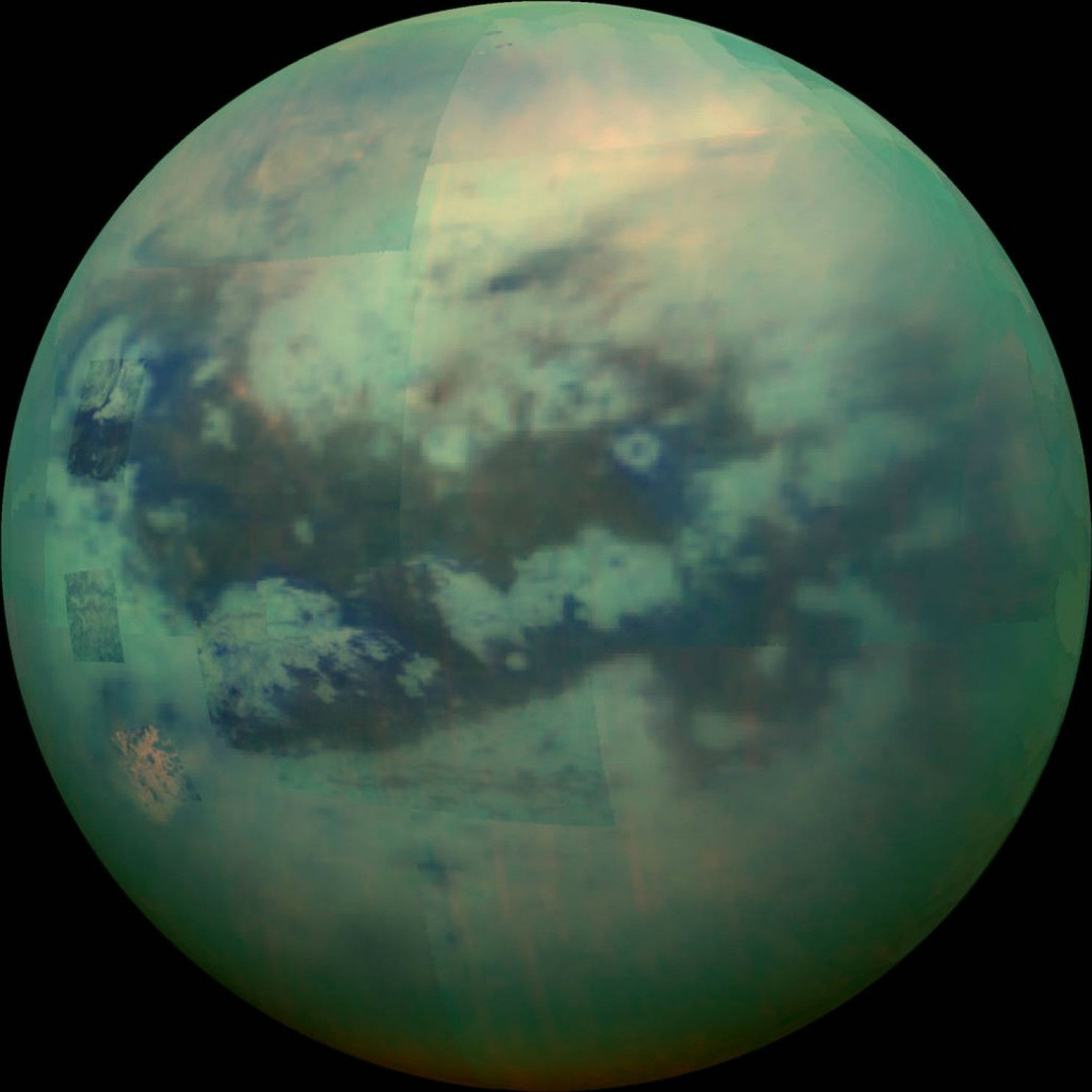NASA can't explain the 'impossible' cloud that's been spotted over Titan

Photo NASA
NASA’s Cassini spacecraft just spotted a mysterious ice cloud over Saturn’s largest moon, Titan, and its appearance challenges everything we thought we knew about the moon’s atmosphere.
First spotted decades ago by NASA's Voyager 1 spacecraft, the cloud has reappeared for the second time, and it's somehow made up of compounds that barely exist in Titan’s atmosphere. So where did it come from?
"The appearance of this ice cloud goes against everything we know about the way clouds form on Titan," said lead researcher Carrie Anderson from NASA's Goddard Space Flight Centre.
Back when Voyager 1 first spotted this cloud in Titan’s stratosphere during its 1980-81 Saturn flyby, scientists determined that it was formed from a compound of carbon and nitrogen called dicyanoacetylene (C4N2).
C4N2 is a key compound for Titan, because it’s part of a unique 'chemical cocktail' that gives the moon its hazy, burnt-orange atmosphere.
But there was a problem - up in the stratosphere where the C4N2 cloud had formed, scientists detected less than 1 percent of the C4N2 gas needed for the cloud to condense and form.
In other words, there simply isn’t enough C4N2 in Titan’s stratosphere to facilitate cloud formation, according to our current understanding of the laws of thermodynamics.
Fast-forward to now, and NASA’s Cassini spacecraft has just sent back data from its latest Titan flyby to reveal that the same type of cloud is there, up in the giant moon’s stratosphere, and it’s still made from an 'impossible' amount of C4N2.
Titan is one of the most exciting places in our Solar System, because it’s basically like a frozen version of Earth, with mountain chains and rolling dunes on its surface, protected by a thick, smoggy atmosphere.
In fact, Titan is the only moon in the Solar System known to maintain such a dense, nitrogen-rich atmosphere, and it's the only celestial body other than Earth found to have stable pools of liquid on its surface.
"In many respects, Saturn's largest moon, Titan, is one of the most Earth-like worlds we have found to date," says NASA.
"With its thick atmosphere and organic-rich chemistry, Titan resembles a frozen version of Earth, several billion years ago, before life began pumping oxygen into our atmosphere."
If you look at Titan, getting past all that orangey haze, you can see just how similar it looks to our own home planet:

Photo NASA
And researchers think processes here on Earth could be key to what’s going on in Titan’s atmosphere to form its mysterious cloud.
On Earth, our clouds form thanks to a continuous cycle of evaporation and condensation of water. One of the many Earth-like characteristics of Titan is that the same kind of cycle takes place in Titan's troposphere - the lowest layer of the atmosphere, that sits just below the stratosphere - but with methane instead of water.
Evidence suggests that things in Titan's troposphere follow the same rules as things in our own troposphere - and this is where its various weather patterns are thought to originate, just like on Earth. But a different condensation process appears to be taking place in the stratosphere at Titan's north and south winter poles.
As NASA explains, circulation patterns force warm gases to move downward at the pole, and this causes layers of gas to condense as they sink through cooler and cooler layers of the polar stratosphere.
This means clouds can form up in Titan's stratosphere because levels of air temperature and pressure at the poles are enough for this vapour to condense into ice and reach a kind of 'equilibrium'.
"For clouds that condense, this equilibrium is mandatory, like the law of gravity,"says one of the researchers, Robert Samuelson, from NASA's Goddard Space Flight Centre.
This is all pretty straightforward, and Titan would be perfectly normal if it weren't for the fact that the cloud in its stratosphere is made from dicyanoacetylene (C4N2).
"[T]he numbers don't compute for the cloud made from dicyanoacetylene," says NASA. "The scientists determined that they would need at least 100 times more vapour to form an ice cloud where the cloud top was observed by Cassini's CIRS [Composite Infrared Spectrometer]."
While nothing's been confirmed yet, the team's leading hypothesis for why this is the case is based on clouds that exist in Earth's atmosphere and damage ourozone layer.
As Rachel Feltman explains for The Washington Post, there are certain clouds above Earth that forego condensation altogether, and form instead through a kind of 'solid-state' chemistry based on the interactions of ice particles.
This is how chlorine-based chemicals in pollution make their way up into Earth's stratosphere from the ground, and end up eating away at the ozone layer, and a similar process could be allowing for new supplies of C4N2 to be produced in Titan's stratosphere.
As Feltman reports:
"[C]yanoacetylene, a more common compound containing hydrogen, carbon, and nitrogen, could become coated with hydrogen cyanide as it moved down the stratosphere in the form of icy crystals.
If ultraviolet rays from the Sun struck one of these dual-layer ice crystals, the resulting chemical reaction would release dicyanoacetylene and hydrogen. Voila, a cloud!"
The hypothesis will need to be confirmed through further Cassini observations, so until then, Titan's cloud remains a mystery.
And with Cassini's mission coming to a close next year, time is running out. Let's hope the hardest working spaceprobe in the Solar System can give us some answers before then.
The research has been published in Geophysical Research Letters.
Bron: http://www.sciencealert.com/nasa-can-t-explain-the-impossible-cloud-that-just-appeared-over-titan | Gewijzigd: 1 februari 2017, 09:46 uur, door Joyce.s

 NASA can't explain the 'impossible' cloud that's been spotted over Titan
NASA can't explain the 'impossible' cloud that's been spotted over Titan




